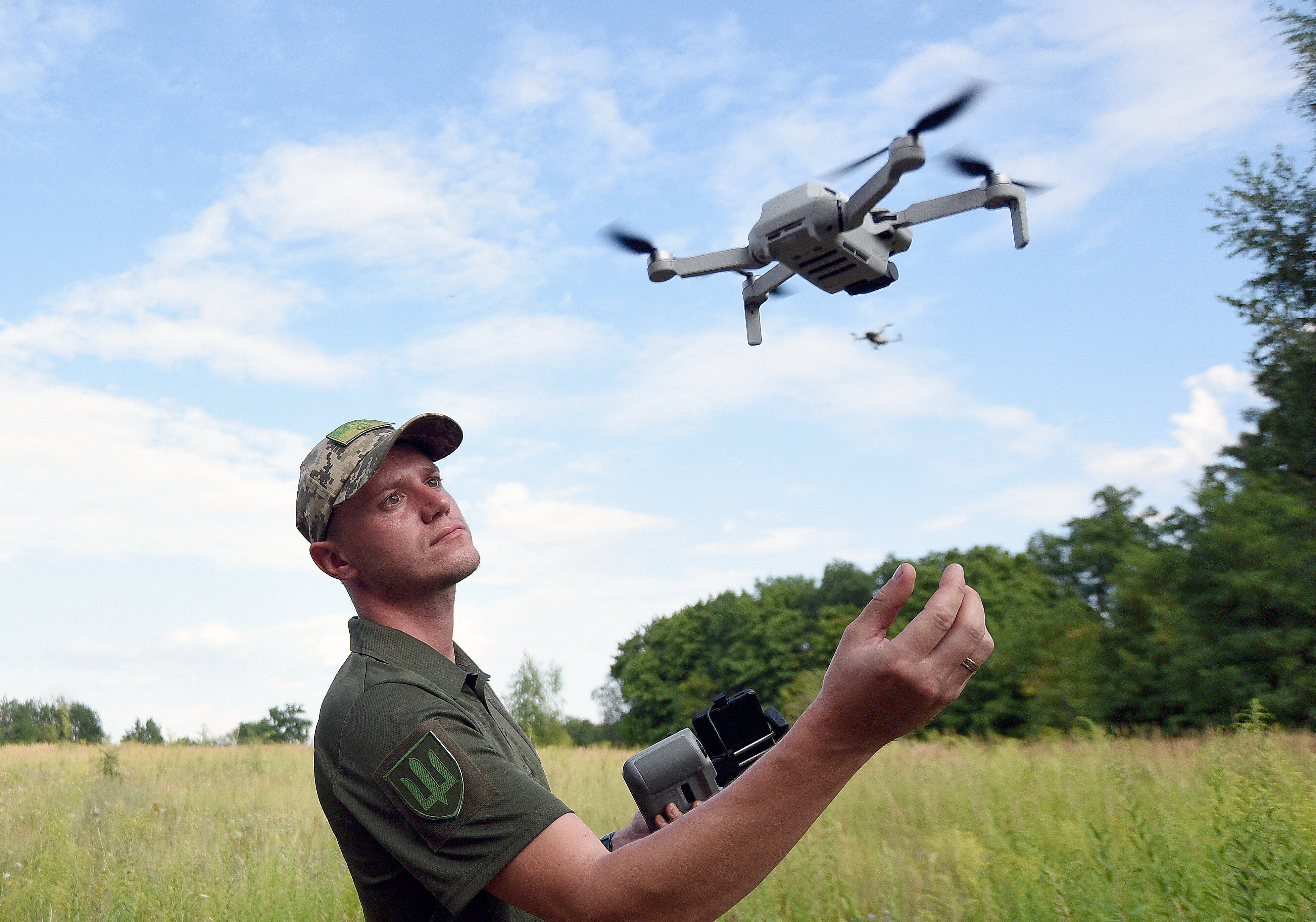War in Europe
Use of Technologies in the Russia-Ukraine War

A serviceman looks at a UAV at the base where Ukrainian military personnel learn to control drones for combat missions, Kyiv Region, northern Ukraine.
© picture alliance / abaca | Ruslan Kaniuka/Ukrinform/ABACAThe 21st century has brought significant new developments in warfare. Technological development, both intuitively and intentionally, led to upgrades in military operations and tactics. The Russian invasion of Ukraine is an evident demonstration of how new technologies have shifted traditional warfare. However, the concept of war did not change, as Clausewitz noted: “War is thus an act of force to compel our enemy to do our will”.[1] The question is what kind of new technologies and tools are utilized in current warfare, and how these changes have altered the conventional thinking of an invasion campaign. Most importantly, whether the nature of war changed to achieve that same ultimate goal of compelling enemy to do our will.
In the Russia-Ukraine war, a handful of advanced military technologies have been tested in combat. Slowly but steadily, with Western support, Ukrainian forces have been enabled to be armed with the most sophisticated defensive weapons. The portable anti-tank missile Javelin, developed in 1989, is one of them, and has proven to be extremely effective.[2] Even though Javelin has become a paragon of success in Ukraine and is most definitely the weapon that has altered the course of the Russian invasion in Ukrainian’s favor, destroying over 1500 tanks, it is still a weapon of the past century.
Unmanned Aerial Vehicles (UAV)
Autonomous and unmanned systems are considered the future of warfare. UAVs, on the other hand, are already part of modern warfare. New technologies are transforming the way humans and machines interact and work together. The Russia-Ukraine war has featured more drone technology than any previous war. Over 60 Russian assets have been destroyed to date by drones since the war has begun.[3] They serve a major, but not decisive, role in the success of the Ukrainian armed forces. There are various types of UAVs used by both sides. The most prominent, medium-altitude long-endurance drone, which played a substantial role in Ukrainian operational success, is the Turkish Bayraktar TB2. It carries laser-guided bombs and targets vehicles, troops and military stations.[4] Another, most commonly used UAV in the Russia-Ukraine war is the U.S. made Switchblade and Russian Lantset, also known as “Kamikaze drone”. It can be carried by a single person in a backpack and has the ability to loiter and search for targets; it then crashes into the target, detonating the warhead it carries.[5]
Even though the drones mentioned above are highly effective, their price is relatively high. The most commonly UAVs used by Ukrainian soldiers are simple, commercial drones, with integrated high-resolution cameras that can be paired with a smartphone, which one can find on e-commerce platforms to purchase. Soldiers use them for intelligence, surveillance and reconnaissance, which puts them one step ahead of the enemy.
Artificial Intelligence (AI)
In this information and social media era, it simply takes one click on the phone and a person can attain an enormous amount of information. This brings back the idea of great military strategist, Sun Tzu, “Know your enemy, know yourself, in one hundred battles, you will never be in peril.”[6] Clearly, Sun Tzu never imagined the existence of the internet, or other developments that intelligence services are using to attain desired data. Nevertheless, the idea of searching for information and being aware of the capabilities of an enemy stays the same. At this point in time, Ukrainian Armed Forces could be considered as one of the most effective and capable armed forces on the planet. The major reason for this notion is that Ukrainians have access to the intelligence and data gathered from the most powerful intelligence services in the world.[7] Precise strikes, effective surveillance and reconnaissance can at least in part be attributed to the knowledge which the Ministry of Defence of Ukraine is receiving from the western allies.
Equally important is the fact that Ukrainians themselves are successfully applying advanced AI tools to publicly available imagery, producing critical information. Ukraine has partnered with Clearview AI, which offers Ukrainian software that uses facial recognition to discover the social media profiles of deceased soldiers, which authorities then use to notify relatives and transfer bodies to the families.[8]
Ukrainians are taking advantage of the Russian soldiers’ widespread use of unencrypted communications.[9] AI focused Tech Company, Primer, modified their commercial AI-enabled voice transcription and translation service to process intercepted Russian communications and automatically highlight information relevant to the Ukrainian armed forces in a searchable text database. AI operates at speeds that would require hundreds of analysts to process the same amount of data.
Space
Since the war began, Mykhailo Fedorov, the Minister of Digital Transformation and Vice Prime Minister of Ukraine, tweeted multiple urgent pleas for direct assistance to the leadership of commercial space companies. Fedorov gained international fame after Elon Musk responded to his tweet and pledged to deliver aid to Starlink internet to Ukraine. Musk stayed loyal to his word. Today, Ukrainian drones are using Starlink to attack Russian forward positions. Other commercial space companies have responded as well. These companies are predominately focused on remote sensing and satellite communications. The support they have provided has been critical in delivering timely intelligence on Russian troop movements and keeping Ukrainian military communications networks operational.[10]
Clearly, the Russia-Ukraine war is the most technologically advanced war that humanity has ever seen thus far. War and everything intertwined in it has clearly changed and evolved. However, the nature of war that drives people and states to confront each other remains the same. Even though new technologies, new fields of warfare have developed, the ultimate goal remains the same – to be superior amongst all and protect your sovereignty. After the war is over, drastic changes and reforms are expected in the military throughout the world. Every state that is invested in its national security, now, collects data using various technics including AI. Once the war is over, this database will serve as a manual for future defense and security development. Warfare has shifted to a more technologically advanced state, with new interdependencies created reaching beyond weapons systems alone; military strategists, commanders and even field operators need to adapt to this shift, with the right instruments and innovative tactics.
[1] Karl von Clausewitz, On the nature of war, Chapter 1.
[2] Ukrainian Armed Forces, The total combat losses of the enemy from 24.02 to 23.06
[3] Winkie, “Ukraine Says Its Drones Hit Russian Fast Boats at Sea.”
[4] Sutton, “Incredible Success Of Ukraine’s Bayraktar TB2: The Ghost Of Snake Island – Naval News.”
[5] Huet, “What Are the Switchblade ‘suicide Drones’ Boosting Ukraine’s Arsenal?”
[6] Sun Tzu, “The Art of War”, Oxford University press.
[7] Knorr-Evans, “US Passes Intelligence to Ukraine: What Have They Shared? Russian Generals...Sinking of Mosvka - AS USA.”
[8] Dangwal, “Ukraine Uses ‘Controversial’ Artificial Intelligence Tech In Its War Against Russia As Kiev Looks To Win The ‘Digital War.’”
[9] Allen, “Across Drones, AI, and Space, Commercial Tech Is Flexing Military Muscle in Ukraine.”
[10] Allen, “Across Drones, AI, and Space, Commercial Tech Is Flexing Military Muscle in Ukraine.”
